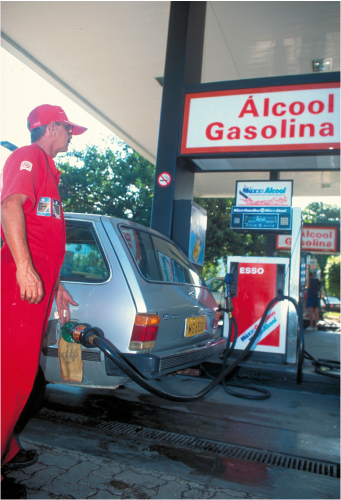Practical use
The most common way to introduce biofuels has been as a 5% blend with mineral petrol or diesel. This requires no adaptation to a vehicle's engine or fuel system, but only results in a small cut in emissions.
High percentage blend alcohol fuels require modified engines – for instance, flex-fuel vehicles are able to run on fuel consisting of up to 85% alcohol blended with petrol (known as E85). As alcohol has a relatively low energy density (per unit volume), this also means that such vehicles require much larger fuel tanks than petrol vehicles.
While high percentage blend biodiesel fuels can be used in some older conventional diesel engines, there is an issue of increased corrosion of rubber seals and piping, so replacement with non-rubber alternatives is advised. Biodiesel has only a slightly lower energy density than mineral diesel, so standard-size fuel tanks are fine, although fuel consumption is about 5% worse.
A number of countries have introduced policies to promote biofuels. During the 1970s and 1980s, ethanol produced from sugar cane was vigorously promoted in Brazil (Figure 10), both as a response to a slump in the global price of sugar and to reduce the country's dependence on foreign oil imports.

In the USA, energy security concerns in the wake of the 1970s oil crisis led to the serious development of ethanol production from energy crops (particularly maize). This was accelerated following the Energy Policy Act of 1994, and in 2005 the USA overtook Brazil as the world's largest ethanol producer. However, unlike ethanol derived from sugar cane, which has significant carbon benefits, 'corn ethanol' can lead to an increase in fuel life cycle CO2 emissions – this is detailed on the next page.
In Europe, the EU Biofuels Directive of May 2003 stipulated the replacement of 5.75% of all transport fossil fuels (petrol and diesel) with biofuels by 2010. In order to comply with this directive, in 2008 the UK introduced the Renewable Transport Fuels Obligation specifying that the amount of biofuel in UK petrol and diesel increase annually to around 5% (by volume) by April 2013 and remain at that level for subsequent years (see 'Renewable Transport Fuels Obligation' in Department for Transport, 2012a).
Activity 6 (exploratory)
What has motivated the adoption of the alternative fuels considered so far (both biofuels and CNG/LPG)? Is it energy security, energy shortage, local air-quality emissions, climate change emissions or something else?
Discussion
Energy security and economic reasons seem to have played a major role in the initial development of many alternative fuels. In some instances, particularly the use of CNG in heavy vehicles, local air-quality emissions have also been important. The approaches that seem to have had most support are those that address a combination of these factors.
